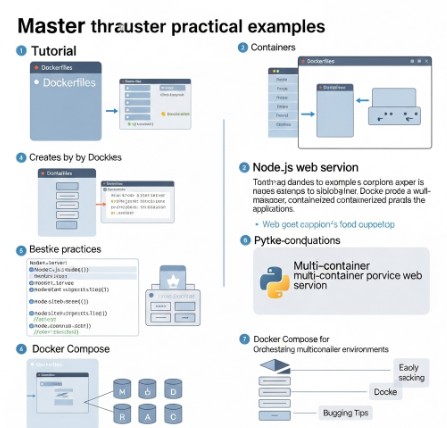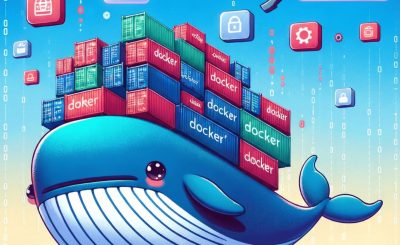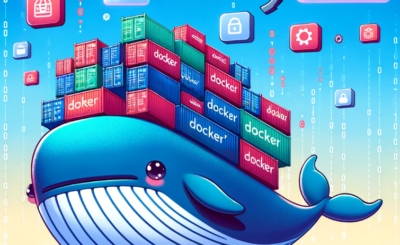Are you struggling to understand Docker and its practical applications? This comprehensive Docker Tutorial Examples guide will walk you through the basics and advanced concepts of Docker, providing practical examples to solidify your understanding. We’ll cover everything from creating simple containers to managing complex applications, ensuring you gain the skills needed to leverage the power of Docker in your development workflow. Whether you’re a DevOps engineer, developer, or system administrator, this Docker Tutorial Examples guide will equip you with the knowledge to effectively utilize Docker in your projects. This tutorial will help you overcome the common challenges associated with setting up and managing consistent development environments.
Table of Contents
- 1 Understanding Docker Fundamentals
- 2 Docker Tutorial Examples: Your First Container
- 3 Docker Tutorial Examples: Building a Custom Image
- 4 Docker Tutorial Examples: Orchestration with Docker Compose
- 5 Docker Tutorial Examples: Docker Volumes
- 6 Docker Tutorial Examples: Networking with Docker
- 7 Frequently Asked Questions
- 8 Conclusion
Understanding Docker Fundamentals
Before diving into practical Docker Tutorial Examples, let’s establish a foundational understanding of Docker’s core components. Docker uses containers, isolated environments that package an application and its dependencies. This ensures consistent execution regardless of the underlying infrastructure.
Key Docker Components
- Docker Images: Read-only templates that serve as blueprints for creating containers.
- Docker Containers: Running instances of Docker images.
- Docker Hub: A public registry containing a vast library of pre-built Docker images.
- Dockerfile: A text file containing instructions for building a Docker image.
Docker Tutorial Examples: Your First Container
Let’s create our first Docker container using a pre-built image from Docker Hub. We’ll use the official Nginx web server image. This Docker Tutorial Examples section focuses on the most basic application.
Steps to Run Your First Container
- Pull the Nginx image: Open your terminal and run
docker pull nginx. This downloads the Nginx image from Docker Hub. - Run the container: Execute
docker run -d -p 8080:80 nginx. This creates and starts a container in detached mode (-d), mapping port 8080 on your host machine to port 80 on the container (-p 8080:80). - Access the Nginx server: Open your web browser and navigate to
http://localhost:8080. You should see the default Nginx welcome page. - Stop and remove the container: To stop the container, run
docker stop(replace with the actual ID). To remove it, usedocker rm.
Docker Tutorial Examples: Building a Custom Image
Now, let’s create a more complex example with a Docker Tutorial Examples focusing on building a custom Docker image from a Dockerfile. This will showcase the power of Docker for consistent application deployments.
Creating a Simple Python Web Application
We’ll build a basic Python web application using Flask and package it into a Docker image.
Step 1: Project Structure
Create the following files:
app.py(Python Flask application)Dockerfile(Docker image instructions)requirements.txt(Python dependencies)
Step 2: app.py
from flask import Flask
app = Flask(__name__)
@app.route("/")
def hello():
return "Hello from Docker!"
if __name__ == "__main__":
app.run(debug=True, host='0.0.0.0', port=5000)Step 3: requirements.txt
FlaskStep 4: Dockerfile
FROM python:3.9-slim-buster
WORKDIR /app
COPY requirements.txt requirements.txt
RUN pip install --no-cache-dir -r requirements.txt
COPY . .
EXPOSE 5000
CMD ["python", "app.py"]
Step 5: Build and Run
- Navigate to the project directory in your terminal.
- Build the image:
docker build -t my-python-app . - Run the container:
docker run -d -p 8000:5000 my-python-app - Access the application:
http://localhost:8000
Docker Tutorial Examples: Orchestration with Docker Compose
For more complex applications involving multiple services, Docker Compose simplifies the management of multiple containers. This section will illustrate a practical example using Docker Compose.
Let’s imagine a web application with a database and a web server. We’ll use Docker Compose to manage both.
Docker Compose Configuration (docker-compose.yml)
version: "3.9"
services:
web:
image: nginx:latest
ports:
- "80:80"
depends_on:
- db
db:
image: postgres:13
ports:
- "5432:5432"
environment:
- POSTGRES_USER=myuser
- POSTGRES_PASSWORD=mypassword
- POSTGRES_DB=mydb
Running with Docker Compose
- Save the above configuration as
docker-compose.yml. - Run
docker-compose up -dto start the containers in detached mode. - Access the Nginx server at
http://localhost. - Stop and remove the containers with
docker-compose down.
Docker Tutorial Examples: Docker Volumes
Data persistence is crucial. Docker volumes provide a mechanism to separate data from the container’s lifecycle, allowing data to persist even if the container is removed. This is a very important section in our Docker Tutorial Examples guide.
Creating and Using a Docker Volume
- Create a volume:
docker volume create my-data-volume - Run a container with the volume:
docker run -d -v my-data-volume:/var/www/html nginx - The data in
/var/www/htmlwill persist even after the container is removed.
Docker Tutorial Examples: Networking with Docker
Docker’s networking capabilities allow containers to communicate with each other. Let’s explore some key networking aspects in this part of our Docker Tutorial Examples.
Understanding Docker Networks
- Default Network: Containers on the default network can communicate using their container names.
- Custom Networks: Create custom networks for more organized communication between containers.
Frequently Asked Questions
What are the benefits of using Docker?
Docker offers several benefits, including improved consistency across development, testing, and production environments, simplified application deployment, resource efficiency through containerization, and enhanced scalability and maintainability.
How does Docker differ from virtual machines?
Docker containers share the host operating system’s kernel, resulting in significantly lower overhead compared to virtual machines which have their own full operating system instances. This makes Docker containers much more lightweight and faster.
Is Docker suitable for all applications?
While Docker is highly versatile, it might not be ideal for all applications. Applications with significant system-level dependencies or those requiring direct access to the underlying hardware might be better suited to virtual machines.
How do I troubleshoot Docker issues?
Docker provides extensive logging capabilities. Checking the logs using commands like docker logs is crucial for debugging. Additionally, Docker’s documentation and community forums are invaluable resources for resolving issues.
What are some best practices for using Docker?
Employing a well-structured Dockerfile, utilizing multi-stage builds to reduce image sizes, implementing robust container networking, and effectively managing data persistence with Docker volumes are key best practices.

Conclusion
This in-depth Docker Tutorial Examples guide has provided a comprehensive overview of Docker, covering fundamental concepts and advanced techniques illustrated with practical examples. From creating simple containers to managing complex applications with Docker Compose, you’ve gained the foundational skills to effectively utilize Docker in your projects. Remember to leverage the wealth of resources available, including official documentation and online communities, to continue learning and mastering Docker. Thank you for reading the DevopsRoles page!

